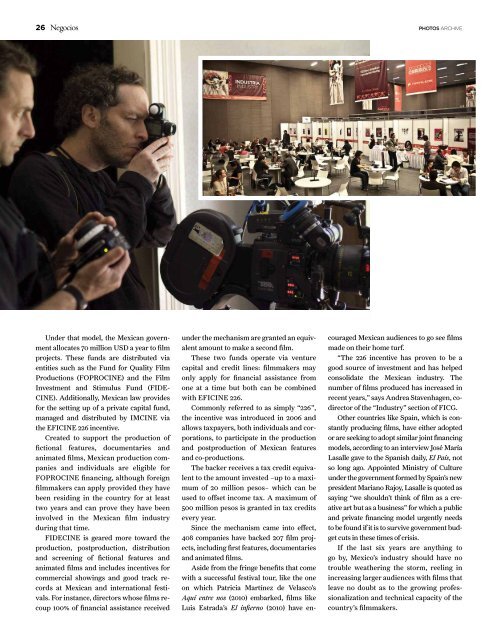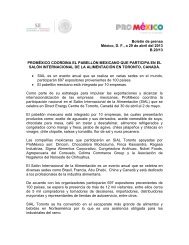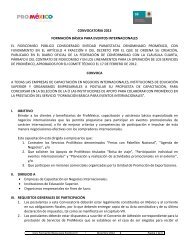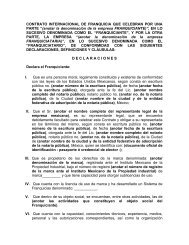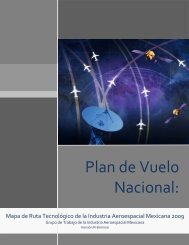the MexiCan filM industry
the MexiCan filM industry
the MexiCan filM industry
Create successful ePaper yourself
Turn your PDF publications into a flip-book with our unique Google optimized e-Paper software.
26 Negocios<br />
photos archive<br />
Under that model, <strong>the</strong> Mexican government<br />
allocates 70 million USD a year to film<br />
projects. These funds are distributed via<br />
entities such as <strong>the</strong> Fund for Quality Film<br />
Productions (FOPROCINE) and <strong>the</strong> Film<br />
Investment and Stimulus Fund (FIDE-<br />
CINE). Additionally, Mexican law provides<br />
for <strong>the</strong> setting up of a private capital fund,<br />
managed and distributed by IMCINE via<br />
<strong>the</strong> EFICINE 226 incentive.<br />
Created to support <strong>the</strong> production of<br />
fictional features, documentaries and<br />
animated films, Mexican production companies<br />
and individuals are eligible for<br />
FOPROCINE financing, although foreign<br />
filmmakers can apply provided <strong>the</strong>y have<br />
been residing in <strong>the</strong> country for at least<br />
two years and can prove <strong>the</strong>y have been<br />
involved in <strong>the</strong> Mexican film <strong>industry</strong><br />
during that time.<br />
FIDECINE is geared more toward <strong>the</strong><br />
production, postproduction, distribution<br />
and screening of fictional features and<br />
animated films and includes incentives for<br />
commercial showings and good track records<br />
at Mexican and international festivals.<br />
For instance, directors whose films recoup<br />
100% of financial assistance received<br />
under <strong>the</strong> mechanism are granted an equivalent<br />
amount to make a second film.<br />
These two funds operate via venture<br />
capital and credit lines: filmmakers may<br />
only apply for financial assistance from<br />
one at a time but both can be combined<br />
with EFICINE 226.<br />
Commonly referred to as simply “226”,<br />
<strong>the</strong> incentive was introduced in 2006 and<br />
allows taxpayers, both individuals and corporations,<br />
to participate in <strong>the</strong> production<br />
and postproduction of Mexican features<br />
and co-productions.<br />
The backer receives a tax credit equivalent<br />
to <strong>the</strong> amount invested –up to a maximum<br />
of 20 million pesos– which can be<br />
used to offset income tax. A maximum of<br />
500 million pesos is granted in tax credits<br />
every year.<br />
Since <strong>the</strong> mechanism came into effect,<br />
408 companies have backed 207 film projects,<br />
including first features, documentaries<br />
and animated films.<br />
Aside from <strong>the</strong> fringe benefits that come<br />
with a successful festival tour, like <strong>the</strong> one<br />
on which Patricia Martínez de Velasco’s<br />
Aquí entre nos (2010) embarked, films like<br />
Luis Estrada’s El infierno (2010) have encouraged<br />
Mexican audiences to go see films<br />
made on <strong>the</strong>ir home turf.<br />
“The 226 incentive has proven to be a<br />
good source of investment and has helped<br />
consolidate <strong>the</strong> Mexican <strong>industry</strong>. The<br />
number of films produced has increased in<br />
recent years,” says Andrea Stavenhagen, codirector<br />
of <strong>the</strong> “Industry” section of FICG.<br />
O<strong>the</strong>r countries like Spain, which is constantly<br />
producing films, have ei<strong>the</strong>r adopted<br />
or are seeking to adopt similar joint financing<br />
models, according to an interview José María<br />
Lasalle gave to <strong>the</strong> Spanish daily, El País, not<br />
so long ago. Appointed Ministry of Culture<br />
under <strong>the</strong> government formed by Spain’s new<br />
president Mariano Rajoy, Lasalle is quoted as<br />
saying “we shouldn’t think of film as a creative<br />
art but as a business” for which a public<br />
and private financing model urgently needs<br />
to be found if it is to survive government budget<br />
cuts in <strong>the</strong>se times of crisis.<br />
If <strong>the</strong> last six years are anything to<br />
go by, Mexico’s <strong>industry</strong> should have no<br />
trouble wea<strong>the</strong>ring <strong>the</strong> storm, reeling in<br />
increasing larger audiences with films that<br />
leave no doubt as to <strong>the</strong> growing professionalization<br />
and technical capacity of <strong>the</strong><br />
country’s filmmakers.


